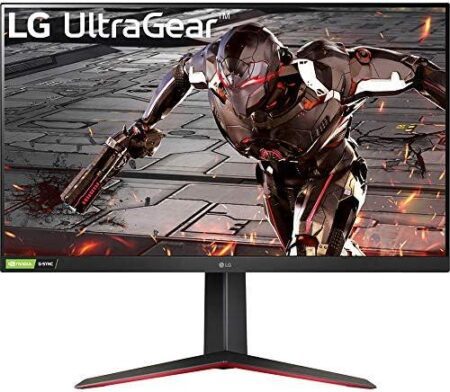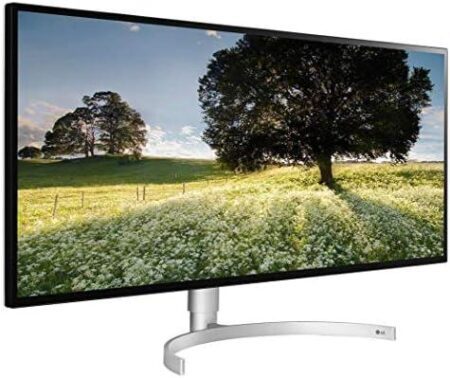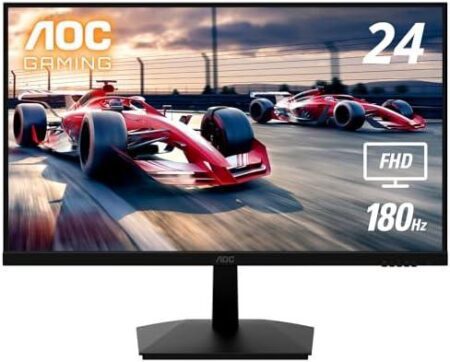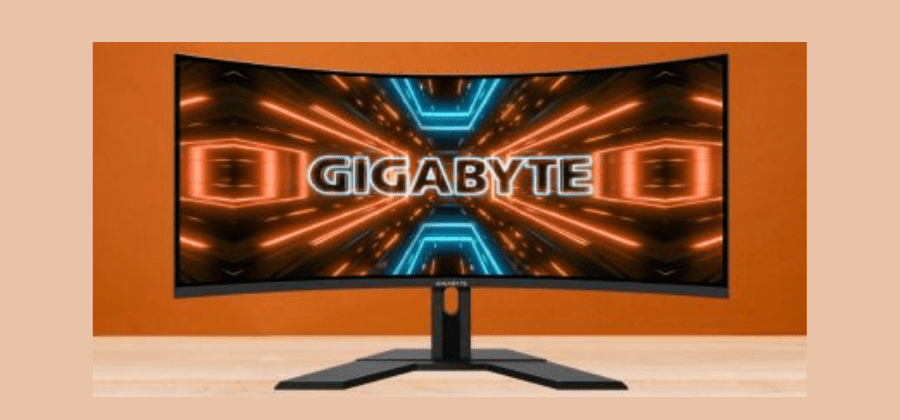
See things big thanks to the ultrawide! This is what Gigabyte offers us with its M34WQ, a gaming monitor that saves screen space, practical for productivity tasks such as extending your field of vision in-game. And despite its 34 inches and 21 format: 9, this screen remains quite affordable. Do the image quality and performance still manage to convince us? The answer to our test.
By succeeding the M34WQC, the monitor we are reviewing today slightly revises its ambitions by opting not for a curved VA panel, but on the contrary for a flat IPS panel, still at 34 inches. Displayed with a refresh rate of 144 Hz, VESA Display HDR400 certification, and an unadorned design to bring the price down, the M34WQ is also part of a range that was the first to offer a directly integrated KWV module on-screen, as found on the expensive AORUS FI32U and FO48U.
All measurements taken in this test were recorded with CalMAN Ultimate software, an X-Rite i1 Display Pro Plus probe, and a Leo Bodnar Input Lag measurement box.
Related Article: Gigabyte Aorus Fo48U Review
Design and ergonomics
Aside from the fact that the curved panel has been dropped, the Gigabyte M34WQ shares many similarities with its predecessor, starting with the design and support, as well as the materials used.
Not that the finishes are bad, however, we feel that we are faced with a monitor who is trying to save money to maintain a floor price. To tell the truth, it’s not so bad, because it remains simple, without frills, with a very classic design and aesthetics, while benefiting from an assembly that seems robust despite the use of plastic.
The support offers the ergonomic settings that we expect, it is however quite imposing on the desk. It occupies about 25 cm in depth and almost 50 cm in width taking the two furthest points. Anyway, it perfectly holds the screen, and it’s 7.1 kg (not counting the weight of the support).
The ergonomics are not exceptional, but sufficient for a screen of this format. We take advantage of a nice amplitude of 13 cm for height adjustment, a rotation of -30° to 30° from left to right, and angles of inclination between -20° and 5° towards the front and back. Like the majority of ultrawide screens, the M34WQ cannot be placed in portrait mode.
There is also a rudimentary cable passage; it is possible to opt for a wall mounting VESA 100×100. We appreciate the thin screen borders (on three sides), only the lower part is wide, as with most screens.
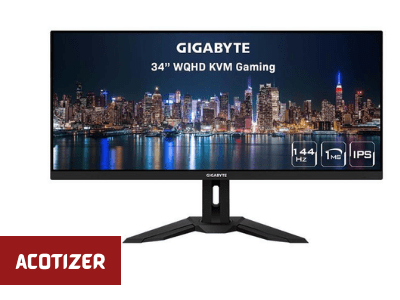
Gigabyte M34WQ
✓A careful factory calibration
✓Responsiveness of the IPS panel
✓Input lag at its lowest
✓Switch KVM et USB-C
✓FreeSync Premium / G-Sync
✗Anecdotal HDR rendering
✗Low contrast
✗USB-C limited to 15W
This is an excellent contender for anyone looking for an affordable widescreen in 21:9 format. Fast, responsive, offering a large display space, it is both recommendable in the office and in games. However, we expect much more in terms of HDR rendering and image quality (contrast), things we forgive him given its price/performance ratio and its wide diagonal.
Related Article: Acer Gn245Hq Review
Connectors
Gigabyte offers the essentials in terms of connectors and even gives a little more than some other affordable monitors. There is a DisplayPort 1.4, 2 HDMI 2.0 ports, two USB 3.0, and a 3.5 mm audio output. USB-C is also included with some interesting features, we think of DP Alt Mode and the possibility of powering an external device, up to 15 W only.
Finally, the KVM switch is on the program with the presence of a dedicated button for this purpose, above the OSD control joystick. It allows you to control and switch from one device to another while keeping the same keyboard/mouse/screen set. Note that the monitor uses an internal power supply, in fact, we do not have a power supply lying around below the desk.
Related Article: Aoc E2352Phz Review
Software ergonomics and settings
The M34WQ’s OSD is somewhat different from the AORUS monitors we’ve tested recently. However, it incorporates the main lines and features, with 6 predefined image modes plus three “custom” modes and the possibility of saving three different personalized profiles.
There are practical functions such as PIP / PBP, the KWM switch, or a “Game Assist” section with a dashboard, a series of crosshairs, or even the display of information (FPS counter, stopwatch, etc.).
The M34WQ also features Aim Stabilizer Sync and Smart OD, black frame insertion technology, and an overdrive option that automatically adjusts based on frame rate.
As already mentioned, the OSD is controlled via a simple joystick. However, it is compatible with the OSD Sidekick application, a slightly easier way to make changes, with a keyboard and mouse.
Image quality
We selected the “Custom 1” mode to perform our measurements. These modes are distinguished by the fact that they control all the advanced settings, and not only the brightness as is the case with the sRGB mode. The other modes give access to a lot of settings, except “6 axis Color” which allows you to adjust the hue and saturation of 6 different colors, as its name suggests.
Without any prior adjustment, the image mode chosen shows a rather satisfactory calibration. The image may seem slightly too warm due to a color temperature measured at 6344 K, nothing really bothersome in use, however. Both grayscale and gamma curves show good results. The gamma follows the reference curve relatively well, only a small dropout is visible on the highest brightnesses.
The average Delta E is also satisfactory, with a measurement of 3.07. This is just above the limit beyond which the human eye can perceive chromatic shifts. This is obviously an average, some shades show more significant drifts, as can be seen on the blue, while others are well below this threshold of 3.
The sRGB space is perfectly represented, almost entirely, at 99.8% to be exact. On the other hand, the coverage of the Adobe RGB space will not be enough for those who need it, it does not exceed 81%.
Gigabyte’s promises are kept regarding brightness. This reaches a peak of 400.2 cd/m² in SDR; combined with an effective matte coating to counter reflections, we have a screen that retains excellent visibility in most situations. Despite everything, the limits of the IPS panel are there. By this we mean that the contrast has a relatively low ratio of 1025:1. Lacking a local dimming option, this monitor displays blacks that may not appear totally black, which is particularly noticeable when placed in a low-light environment.
In terms of uniformity, the M34WQ does quite well even if we notice a slight differential on the sides of the screen. The low contrast is obviously not entirely satisfied with regard to the homogeneity of the black, on the other hand, our test copy does not suffer from light leaks or IPS Glow.
Related Article: How To Choose A Best Monitor
Unconvincing management of HDR
Enabling HDR only brings a slight added value to this monitor. With a measurement of 405.9 cd / m², its light peak is slightly higher than that in SDR and is insufficient to deliver a true HDR rendering worthy of the name.
On the other hand, the M34WQ has quite good colorimetric coverage in HDR. It displays, according to our probe, 92.29% of the DCI-P3 space and 72.85% of the Rec. 2020.
There is also increased precision when the HDR is activated, with an average Delta E reduced to 2.32, almost without there being any chromatic drift.
However, we should not expect the HDR experience to have a real impact on the rendering in-game. Due to the generally too low brightness, the absence of local dimming, and contrast, he too shows his limits. We nevertheless obtain bright and rich colors, and it is clear that this screen behaves well on this point.
Related Article: Hp Omen 25I Review
Performances
If the M43WQ delivers an image that is probably less deep than its predecessor (the M34WQC), it nevertheless offers some advantages in terms of performance, thanks to an IPS panel that is more reactive.
Using the tools made available by Blur Buster and Lagom, we have seen that the response times of this monitor are excellent. Pixel transitions happen quickly, so motion blur is largely contained. Good news, because it is not especially necessary with this monitor to choose an overdrive option that would induce overshoot or overshoot .. In our experience, it’s best to stick with the “Picture Quality” overdrive option. An overshoot is indeed visible with the “Speed” option, while the “Smart OD” mode does not seem to positively (or negatively) affect the movements.
Added to this good pixel behavior is latency – input lag – among the lowest we’ve seen this year, with just 8.5 ms. Remember that our measurement box only sends a signal at 60 Hz, this measurement would probably be displayed with an even lower value at the maximum refresh rate of the panel.
Let’s not forget to underline, to finish, the excellent management of the VRR of this monitor. Compatible with G-Sync and FreeSync Premium technologies, the M34WQ showed no annoyance when running Nvidia Pendulum. Despite not appearing in the official list of G-Sync Compatible monitors, our monitor is well recognized by Nvidia graphics cards and performs flawlessly over the 48-144Hz range, via DisplayPort only. The FreeSync works via DisplayPort via HDMI but is limited to a maximum refresh rate of 100 Hz in the second case.
Related Article: Huawei Mateview Gt Reviews
Power consumption
The Gigabyte M34WQ has average power consumption for a monitor of this type. By following our usual protocol, we note an electricity consumption of 117 W/m².
Gigabyte M34WQ: the opinion of Acotizer
Fast and responsive, the Gigabyte M34WQ is one of the best ultrawide screens at this price point. However, it is not the only one to position itself in this way in this market, we are thinking in particular of the Huawei MateView GT or the gaming monitor from Xiaomi, two references which also offer a curved panel.
These references are similar in many respects. Finally, the M34WQ stands out by offering careful factory calibration, a KVM switch, and practical features, as well as a flat-screen that some will prefer over a curved model. Finally, the whole thing is supported by excellent in-game performance thanks to a responsive IPS panel which has the advantage of being much less impacted by ghosting than the VA panels of Huawei and Xiaomi monitors.
All this is not without compromise, alas. You have to be satisfied with an HDR rendering that is too insufficient, and rather mediocre contrasts with blacks that clearly lack depth and seem washed out, or even a noticeable blooming in certain situations.






























































































































































